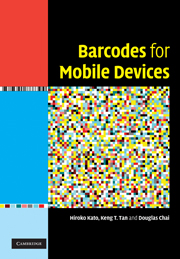Book contents
- Frontmatter
- Contents
- Preface
- 1 Introduction
- 2 Barcode technology evolution
- 3 Two-dimensional barcode for mobile phones
- 4 Evolution of barcode applications
- 5 Technologies for enhancing barcode robustness
- 6 A prototype colour 2D barcode development
- 7 Evaluation of the prototype colour 2D barcode
- Appendices
- References
- Index
- Plate section
6 - A prototype colour 2D barcode development
Published online by Cambridge University Press: 06 July 2010
- Frontmatter
- Contents
- Preface
- 1 Introduction
- 2 Barcode technology evolution
- 3 Two-dimensional barcode for mobile phones
- 4 Evolution of barcode applications
- 5 Technologies for enhancing barcode robustness
- 6 A prototype colour 2D barcode development
- 7 Evaluation of the prototype colour 2D barcode
- Appendices
- References
- Index
- Plate section
Summary
Aims of the prototype colour 2D barcode development
As mentioned in Chapter 2, most 2D barcodes were developed to meet special requirements. For example, QR Code was invented in response to the demand for a barcode with greater data capacity than the traditional linear barcodes so that it could collect information about products without accessing a backend database and hence improve the productivity in assembly lines. Visual Code was developed to implement applications for human–computer interaction.
To design a barcode, first of all the purpose of barcode development and the target applications must be determined. The ultimate goal of our barcode development was to implement a 2D barcode system that can provide applications and services ubiquitously, regardless of time, place and occasion. To implement such a system, a barcode must be flexible in both data capacity and network connectivity. Consider, for example, a ringtone downloading service advertised in a magazine. If an index 2D barcode were used, the only option for a user would be to connect his camera phone to the designated Web page and download ringtones via the Internet. Continuous network connectivity has to be guaranteed for this type of service always to be available. Conversely, no network connectivity leads to no service.
With a database 2D barcode with high data capacity, however, it is possible to provide other options. For example, a user can save the uniform resource locators (URLs) of Web sites directly encoded in the barcode in his or her mobile camera phone for later use.
- Type
- Chapter
- Information
- Barcodes for Mobile Devices , pp. 152 - 191Publisher: Cambridge University PressPrint publication year: 2010



